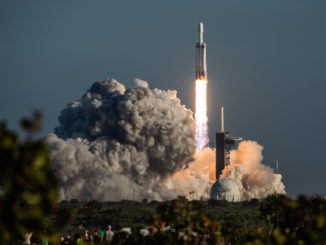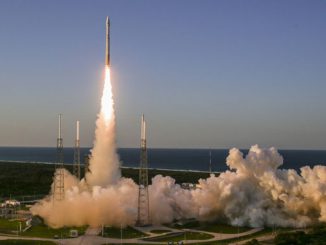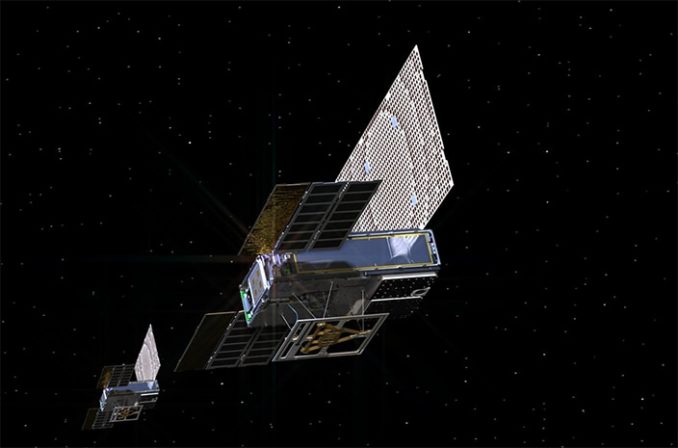
Two CubeSats developed at NASA’s Jet Propulsion Laboratory launched May 5 with the InSight mission to Mars have deployed their miniaturized antennas and captured a distant family portrait of the Earth and the moon.
The twin spacecraft have already set a distance record for CubeSats, and they were moving away from Earth at a range of 1.8 million miles (2.9 million kilometers) as of Wednesday.
The microprobes are part of the Mars Cube One mission, a technology demonstration project that aims to test the feasibility of operating CubeSats in deep space. If successful, the two testbeds could lay the foundation for miniature spacecraft traveling to the moon, asteroids, comets and the planets, accomplishing focused scientific objectives at significantly lower cost than conventional space probes.
Known as MarCO for short, the CubeSats accompanied NASA’s InSight spacecraft during its launch May 5 from Vandenberg Air Force Base in California. Moments after the InSight probe deployed from the forward end of the upper stage of the mission’s Atlas 5 launcher, the twin MarCO CubeSats released from a carrier mounted to the rocket stage’s aft bulkhead.
The two satellites, each about the size of a briefcase, powered up and executed a pre-programmed sequence to activate their on-board avionics and deploy their power-generating solar panels, each with an area of just one square foot. Both CubeSats radioed their status to controllers on Earth a few hours after separating from the Atlas 5 rocket.
Some engineers were waiting anxiously for a status report from the CubeSats, which were last powered up nearly two months before launch, before their stowage inside their deployment mechanism on the rocket.
But the signals came back to Earth, confirming both spacecraft were healthy and ready for post-launch checkouts.
Controllers uplinked commands from the ground for each spacecraft, named MarCO-A and MarCO-B, to deploy two antennas. One of the antennas on each CubeSat, operating in X-band, is designed to beam signals back to Earth from distances as far away as Mars without needing much power, an essential capability for such small spacecraft.
MarCO-A and MarCO-B also deployed a UHF radio antenna, which will receive telemetry from the InSight spacecraft as it descends through the Martian atmosphere Nov. 26. The $18.5 million MarCO mission was conceived primarily as a technology demonstration, but it will attempt to relay status signals from InSight back to Earth during the craft’s critical entry, descent and landing phase.
Andrew Good, a JPL spokesperson, confirmed Wednesday that all antennas on both MarCO CubeSats deployed as planned.
Each CubeSat carries a wide-field camera to verify the successful deployment of the X-band high-gain antennas. One of the validation images downlinked from MarCO-B on May 9 captured a view of the Earth as a “pale blue dot” amid the blackness of space, with the moon lurking nearby.
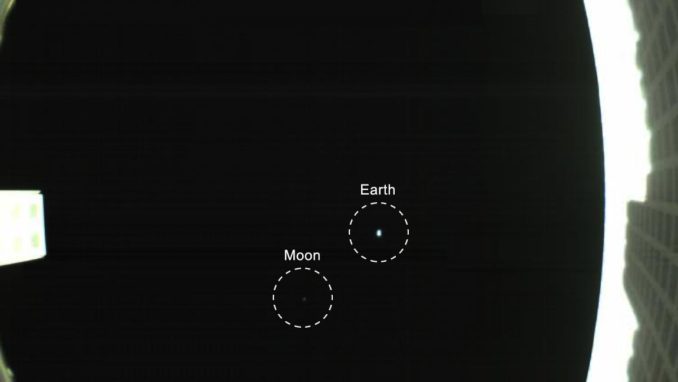
“Consider it our homage to Voyager,” said Andy Klesh, MarCO’s chief engineer at JPL, referring to the famous “Pale Blue Dot” image of Earth taken by the Voyager 1 spacecraft from the outer solar system. “CubeSats have never gone this far into space before, so it’s a big milestone. Both our CubeSats are healthy and functioning properly. We’re looking forward to seeing them travel even farther.”
Nearly 1,000 CubeSats have been launched since 2000, enabling commercial companies, universities, governments and other types of budget-constrained organizations cheaper access to space. A CubeSat can come in various sizes, each based on a cubic “unit” measuring around 4 inches (10 centimeters) on a side.
The MarCO spacecraft are “six-unit” CubeSats, and they are the first of their kind to leave Earth’s vicinity.
Packing all the capability of a traditional spacecraft into a package as small as a CubeSat has been a challenge.
“We need to be able to communicate, to navigate, and to be able to maneuver in the deep space environment,” Klesh said.
The success of InSight’s landing on Mars will not depend on the MarCO CubeSats.
InSight will transmit data during its entry, descent and landing up to NASA’s Mars Reconnaissance Orbiter, which will store the information and send it back to ground controllers more than an hour later. The time delay is required because MRO is not capable of simultaneously receiving information in one band and transmitting data in another.
Giant radio telescopes on Earth will also listen for signals radioed directly from InSight in near real-time — accounting for a time delay due to the vast distance to Mars — but the ground-based antennas are expected to only verify the lander’s “aliveness” during descent and touchdown.
The MarCO CubeSats will sail by Mars at a distance of around 2,175 miles (3,500 kilometers), orienting their UHF antennas toward InSight and pointing their X-band high-gain reflectors to Earth. If the CubeSats work as intended, they will receive detailed UHF telemetry from InSight, re-format the data in an on-board computer, then beam the information to Earth in X-band.
NASA sent two 30-pound (13.5-kilogram) CubeSats for redundancy in case one of the MarCO probes runs into trouble.
Regardless of the success of the MarCO mission, or the other listening options via MRO or ground-based radio telescopes, InSight’s parachute- and rocket-assisted touchdown sequence will be completely autonomous, not requiring any real-time input from engineers on Earth.
One of the crucial technologies embedded inside each MarCO spacecraft is a miniaturized “Iris” radio, about the size of a softball, that crams advanced receive and transmission functions into a package that can fit into a CubeSat. The Iris radio is designed to interface with NASA’s Deep Space Network, a collection of antennas at three sites in California, Spain and Australia that connect with spacecraft traveling throughout the solar system.
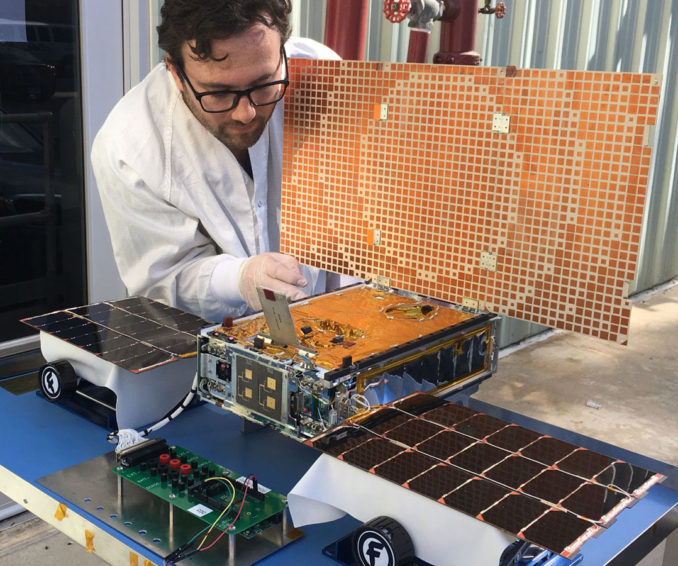
The MarCO CubeSats will test out their propulsion capabilities in the first of several course-correction maneuvers set for late next week, Good said.
But they do not carry the typical propellants used by satellites. Instead of a conventional liquid fuel, like hydrazine, the CubeSats will change its trajectory with compressed R236FA gas, which is commonly used in fire extinguishers.
Engineers who worked on the MarCO mission nicknamed the CubeSats “Wall-E” and “Eva,” based on characters from the 2008 Pixar film. In the movie, the sentient Wall-E robot uses a fire extinguisher to propel through space.
The compressed gas supply will feed eight tiny thrusters on each CubeSat.
According to Good, the twin MarCO spacecraft will conduct their trajectory correction maneuvers one at a time to begin fine-tuning their course toward Mars.
The Atlas 5 rocket intentionally targeted a trajectory slightly offset from Mars during the May 5 launch to ensure the vehicle’s Centaur upper stage would not impact the Red Planet. InSight and the twin MarCO CubeSats will bend their trajectories back toward Mars with a series of maneuvers over the coming months.
Developers are already designing and building CubeSats for future deep space missions, and results from MarCO will help assure engineers their concepts will work far away from Earth.
Thirteen CubeSats will fly on the first launch of NASA’s Space Launch System in 2020, each with standalone missions to study the moon, travel to an asteroid, and conduct other types of research and demonstrations in deep space.
NASA is also planning to seek proposals for CubeSats and other small spacecraft that could ride on future interplanetary launches, adding scientific capability and opportunities for bonus science to already-planned missions, such as the Lucy and Psyche asteroid probes set for launch in 2021 and 2022.
The space agency has funded studies of 19 interplanetary mission concepts using CubeSats and other types of “SmallSats” to help teams advance their work.
Email the author.
Follow Stephen Clark on Twitter: @StephenClark1.

